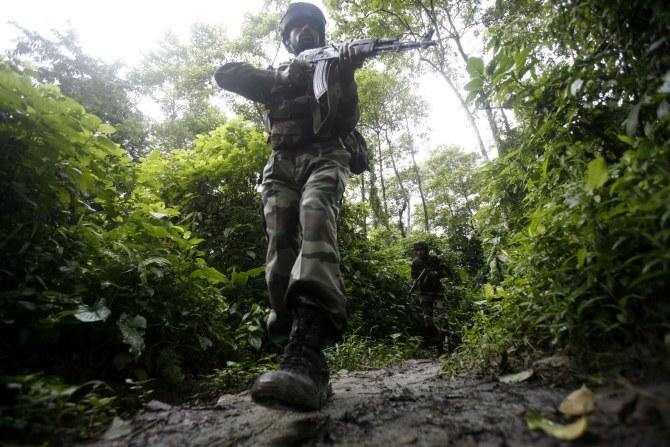
The counter-insurgency operation on the Indo-Myanmar border was being planned for the last three months, much before the June 4 ambush by Naga insurgents that killed 18 Indian soldiers, and the decision to go ahead with the daring attack was not easy one for New Delhi.
Sheela Bhatt provides exclusive details of how the operation was decided.
The counter-insurgency operation that the Indian Army executed to flush out two camps of anti-India militants on Tuesday, was being planned since the last three months.
The ambush on the convoy of soldiers of the Army’s 6th Dogra Infantry, that killed 18 of them in the morning of June 4 in Manipur’s Chandel district, became the trigger to advance the operation by joint forces of the Indian military to June 9.
According to a source in government, Foreign Secretary S Jaishankar had secretly visited Myanmar last month to tie up things with the government there regarding the Indian military operation whenever it took place.
The top level source told Rediff.com that India would have embarked upon ‘hot pursuit’ to flush out militants operating from Myanmar much before June 4, when the convoy was ambushed.
The National Socialist Council of Nagaland-Khaplang was working against Indian peace-keeping efforts while operating from Myanmar. In the north-east more than 300 insurgent groups thrive both overground and underground, but those who attack or shoot Indian security forces and then escape into neighbouring countries pose bigger problems.
Bhutan and Bangladesh, since the last few years, have been acting on their own to help India fight insurgency by taking action against militants taking shelter in their countries but Myanmar was unable to take action proactively. The country, under military rule, faces grave problems at its border with China, too.
Tribal leader S S Khpalang’s NSCN-K was the target of the Indian attack on Tuesday. Khaplang heads the group that is a rival to National Socialist Council of Nagaland-Isak-Muivah. While the Thuingaleng Muivah is engaged in prolonged peace talks with Centre, the breakaway group headed by Khaplang fears that if a final settlement is reached between the central government and the Muivah group then it will lose relevance.
However, the decision to go ahead with the daring attack was not easy one for New Delhi.
Expectedly, the government was deliberating on the political implications in the region. Within the Narendra Modi government's core group, the debate was about what impact it would have on the prime minister's public image. The question was, is it okay to acquire a ‘macho’ image at this juncture, when Modi's diplomacy is taking shape on the global stage? The bold operation to cross into a neighbour’s territory and attack and kill insurgents does not amount to war but is almost a war-like action.
The counter-insurgency operation, and that too a successful one, would inevitably add to Modi's ‘macho’ image. The delay in embarking on the Myanmar operation was to weigh the consequences of acquiring that image which has two sides to it. After such an audacious and bloody operation that has killed more than 20 insurgents, the commentariat will link Modi's emerging persona with the act, since all counter-insurgency operations that involve crossing the border needs the prime minister's okay.
“PM Modi had ordered hot pursuit,” said Minister of State for Information & Broadcasting Colonel (retd) Rajyavardhan Singh Rathore.
He went a bit overboard when he said that, “Western disturbances will also be equally dealt with.”
He told a television channel: "Our PM ordered hot pursuit in which two camps were completely annihilated. While the army carried out the strike, helicopters were on stand-by."
Rathore was clearly trying to project that the government wants to capitalise on the army operation to add to its ‘strong image’. Rathore went as far as saying that, “Friendship and zero tolerance will go hand in hand,” and that, “This is a beginning. India is strong. This message should go to everyone.”
But before the operation, the government and the Prime Minister’s Office were in doubt over its implications it will have for Modi's image, says a source privy to the debates.
The issue about the consequences on the region was debated threadbare. Modi’s foreign policy’s fundamental plank is to make the South Asian Association for Regional Cooperation steady and stronger, in line with the European Union where trade flows freely and border barriers don’t become obstacles to the region's growth.
Will a Myanmar-kind of hot pursuit help the broad goals of Mod's regional policy, or will it have an adverse affect? That was how this particular operation was weighed.
National Security Advisor A K Doval supervised the planning and execution of the operation with aplomb, says the source. The positive side to the operation was that India and Mynamar had an agreement in place to co-operate in border areas where the insurgents are in hiding.
In 2010, when P Chidambaram was the home minister, an agreement was signed with the Myanmar government to curb smuggling, drug-trafficking and providing safe havens for militants. Naturally, then, the Congress's Twitter handle soon began claiming, 'It was under former home minister P Chidambaram that India won the right to pursue insurgents into Myanmar in 2010.'
The Research and Analysis Wing had all the details and data ready since many months about the activities of the insurgent groups in the area which is called ‘Greater Nagaland’ by the militants. The local insurgent groups want a ‘Greater Nagaland’ carved out of the Naga-dominated areas in the neighbouring states within India and contiguous areas in Myanmar.
The Nagaland issue has history, social woes, political support and exclusive culture, that make it formidable.
According to the South Asia Terrorism Portal, the NSCN-K has a cadre strength of approximately 2,000, with a following among the Konyaks of both India and Myanmar, the Pangmeis of Myanmar, the Aos of Mokokchung district, the Phoms and Yimchungers of Tuensang district, the Angamis, the Semas and the Lothas. It commands influence in parts of Nagaland, Tirap and Changlang districts of Arunachal Pradesh, as well as the Hemei and Pangmei settlements in Myanmar.
According to SATP, the NSCN-K runs a government-in-exile called the Government of the People's Republic of Nagaland, NSCN-K. The general headquarters of the GPRN/NSCN-K is located in so-called Eastern Nagaland in Myanmar. Kitovi Zhimomi is its self-styled ‘prime minister’.
Like all such insurgency groups it generates finance through kidnapping, extortion and other terrorist activities.
Also read: Myanmar ops a one-off, can't expect replay on western border
Image: An Indian soldier patrols along the Indo-Mayanmar border. Photograph: Parth Sanyal/Reuters.










